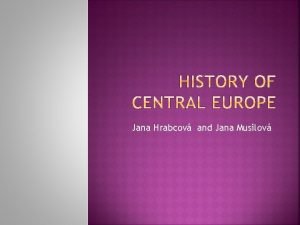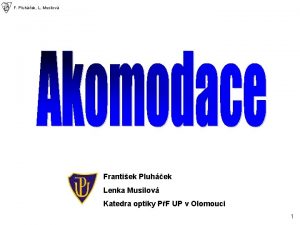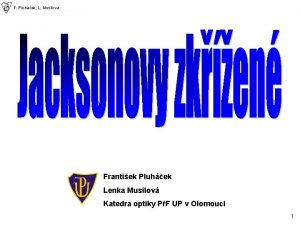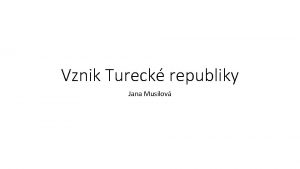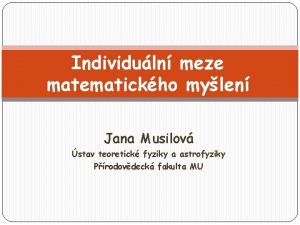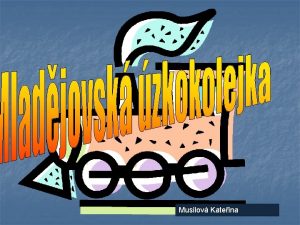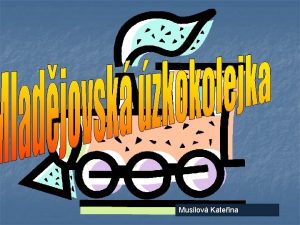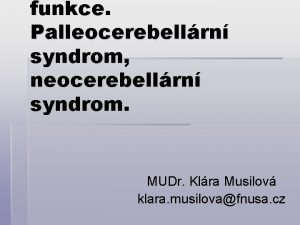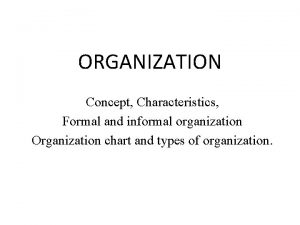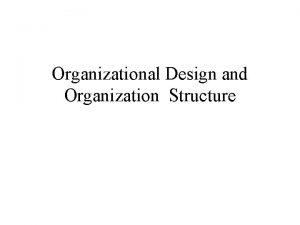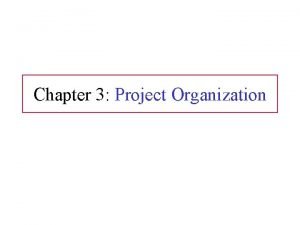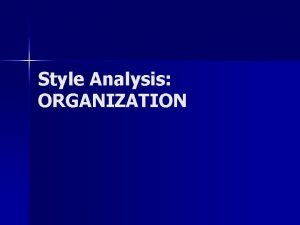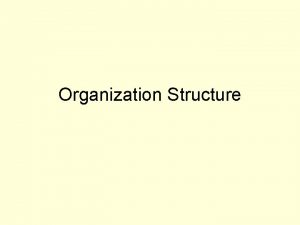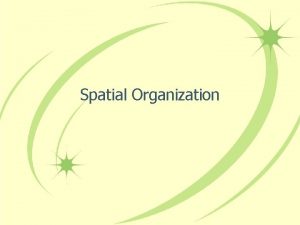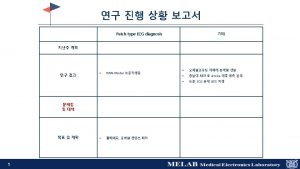Jana kerlov and Jana Musilov Organization of the




























- Slides: 28

Jana Škerlová and Jana Musilová

Organization of the course Definition of the concept of Central Europe and the Introduction to the History of Central Europe in the Middle Ages and the Early Modern Times

Introduction Jana Hrabcová 104456@mail. muni. cz a Jana Musilová 87562@mail. muni. cz Attendance – allowed one unexcused lecture midterm test (09/11/2014) and final test (17/12/2014) 50 – 46 A; 45 – 41 B; 40 – 36 C; 35 – 31 – D; 30 – 25 - E Reading


What is the definition of CENTRAL EUROPE? Or Where is CENTRAL EUROPE?


Demarcation of the region – CE: • Geographical Historical and political development, CE as a cultural unit Religion Political and economical development • • • A Yearbook of Central European Culture characterizes Central Europe "as an abandoned West or a place where East and West collide Germany's Constant Committee for Geographical Names defines Central Europe both as a distinct cultural area and a political region. George Schöpflin and others argue that Central Europe is defined by being "a part of Western Christianity", while Samuel P. Huntington places the region firmly within Western culture.

Germany, Poland, Hungary, Czech Republic, Slovakia, Austria, Switzerland, Liechtenstein (last 3 – Alpine countries) Earlier publication – CE includes also Belgium, the Netherlands, Luxemburg and Romania (1935) x Slovenia, Croatia (new concept) climate, water – shed, mountains

CE – direct influence of „Germany“ (Holy Roman Empire, The Habsburg Monarchy) Division of CE – capitalistic bloc x Soviet Bloc



Cultural concept of CE – till 1795 (disitengration of Poland) – The Habsburg Monarchy, Poland, Lithuania, part of Bavaria (this region had many common interests: politics, literature, architecture, fear of Russian Empire, Osman Empire, Swedes and Prussians) 1867 – emergence of Austria - Hungary and CE as a cultural unit: Czech part, Austria, Slovakia, part of Poland part of Ukraine, Hungary, Transylvania, western Romania, Vojvodina, Croatia, Slovenia, South Tyrol and Bavaria

Before World War I: German idea of “Mitteleuropa“

1904 in Berlin Central European Economic Association (economic integration of Germany and Austria–Hungary with eventual extension to Switzerland, Belgium and the Netherlands) T. G. Masaryk – CE space between Germany and Russia

Emmanuel de Martonne (Germany, Switzerland, Austria, Poland, Czechoslovakia, Hungary and Romania)

Little Entente

As a part of the Eastern Bloc – East Germany, Poland, Czechoslovakia and Hungary E. Schenk (1950)

A. F. A. Mutton (1961)

Meyers Encyclopedia (1980)

Central European Initiative - forum of regional cooperation Albania, Austria, Belarus, Bosnia and Herzegovina, Bulgaria, Croatia, the Czech Republic, Hungary, Italy, Macedonia, Moldova, Montenegro, Poland, Romania, Serbia, Slovakia, Slovenia and Ukraine; founders were Italy, Austria, Hungary and the Socialist Federal Republic of Yugoslavia (SFRY).

Visegrád Group: http: //www. visegradgroup. eu/about

- - CEFTA Former parties are Bulgaria, Czech Republic, Hungary, Poland, Romania, Slovakia and Slovenia. Their CEFTA membership ended when they joined the EU. Croatia is set to join the EU in 2013. of 1 May 2007, the parties of the CEFTA agreement are: Albania, Bosnia and Herzegovina, Croatia, Macedonia, Moldova, Montenegro, Serbia and UNMIK on behalf of Kosovo. [

ERDF (CENTRAL EUROPE PROGRAM) Operational Program 'Central Europe' Program under the European territorial cofunded by European Regional Development Fund (ERDF) Czech Republic, Germany, Italy, Hungary, Austria, Poland, Slovenia, Slovakia

CE – Visegrad group, in a broad sense Austria, Slovinia, Lithuania and sometimes Estonia + Latvia, + Germany Hugh Seton-Watson, Ivan Bérend a György Ránki – CE: Czechoslovakia, Poland, Hungary and Balkans – Eastern Europe Oskar Halecki – 2 macro regions (west and east), region of 2 CEs – important transition zone between West and East x Friedrich Naumann´s Mitteleuropa – alliance between German Empire and Austria – Hungary




Johnson, Lonnie (1996): Where is Central Europe. In. : Central Europe: Enemies, Neighbors, Friends. Oxford University Press, pp. 3 – 12. Tiersky, Ronald (2004). Europe today. Rowman & Littlefield.
 Point-by-point arrangement
Point-by-point arrangement Process organization in computer organization
Process organization in computer organization Hình ảnh bộ gõ cơ thể búng tay
Hình ảnh bộ gõ cơ thể búng tay Slidetodoc
Slidetodoc Bổ thể
Bổ thể Tỉ lệ cơ thể trẻ em
Tỉ lệ cơ thể trẻ em Gấu đi như thế nào
Gấu đi như thế nào Tư thế worm breton là gì
Tư thế worm breton là gì Hát lên người ơi
Hát lên người ơi Các môn thể thao bắt đầu bằng tiếng nhảy
Các môn thể thao bắt đầu bằng tiếng nhảy Thế nào là hệ số cao nhất
Thế nào là hệ số cao nhất Các châu lục và đại dương trên thế giới
Các châu lục và đại dương trên thế giới Công thức tính thế năng
Công thức tính thế năng Trời xanh đây là của chúng ta thể thơ
Trời xanh đây là của chúng ta thể thơ Mật thư anh em như thể tay chân
Mật thư anh em như thể tay chân Làm thế nào để 102-1=99
Làm thế nào để 102-1=99 Phản ứng thế ankan
Phản ứng thế ankan Các châu lục và đại dương trên thế giới
Các châu lục và đại dương trên thế giới Thể thơ truyền thống
Thể thơ truyền thống Quá trình desamine hóa có thể tạo ra
Quá trình desamine hóa có thể tạo ra Một số thể thơ truyền thống
Một số thể thơ truyền thống Cái miệng nó xinh thế chỉ nói điều hay thôi
Cái miệng nó xinh thế chỉ nói điều hay thôi Vẽ hình chiếu vuông góc của vật thể sau
Vẽ hình chiếu vuông góc của vật thể sau Thế nào là sự mỏi cơ
Thế nào là sự mỏi cơ đặc điểm cơ thể của người tối cổ
đặc điểm cơ thể của người tối cổ Ví dụ giọng cùng tên
Ví dụ giọng cùng tên Vẽ hình chiếu đứng bằng cạnh của vật thể
Vẽ hình chiếu đứng bằng cạnh của vật thể Fecboak
Fecboak Thẻ vin
Thẻ vin





























